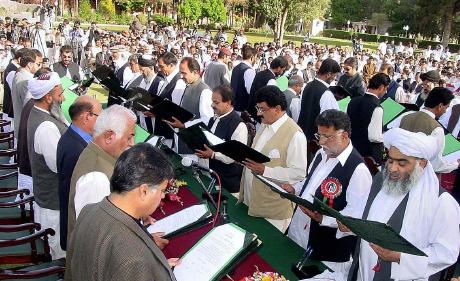Adil Najam
On May 1, Labour Day 2011, four new jobs were created in Balochistan when Chief Minister Nawab Muhammad Aslam Raisani expanded his Provincial Cabinet by four: Rubina Irfan, Ali Madad Jatak, Nasir Jamali and George Jaffar. Here is the news which is nearly not even news any more: The Balochistan Provincial Cabinet (Ministers and Advisers) is now 51 – and the size of the Balochistan Assembly is 64!
Balochistan Chief Minister Nawab Muhammad Aslam Raisani is, of course, a master political strategist. If you have forgotten his famous “Degree, Degree hai. Jali ho ya assli!” line, here is a reminder.
More importantly, this video sheds light on the Raisani Theory of Inclusive Governance and Job Creation. Do please listen to the whole thing. After a recall of the “Degree, Degree hai” line, at around 0.35 minute he starts confronting people who have blocked a road. When told that they are doing so because they do not have jobs, here is his response (at 0.55 minute):
“Jo berozgaar hai woh siyasat meiN hissa lay. Agar uss ka qismat lag gaya tou wazir banay ga, nahiN tou faqir banay ga!”
“Anyone who is without a job should take part in politics. If their luck is good, they will become Ministers. If not, then beggars!”
The Government of Balochistan web-page seems not to have updated their cabinet list just yet, but I can imagine that keeping up with these things is never easy (especially, since even the news reports of these new Ministers did not even say what they would be Ministers of!).
Just how difficult it can be is evidenced from the photograph above – it is about two years old when the original cabinet (of around 38) was being sworn in. As you can see, finding a single table large enough, or even a room wide enough, can be difficult when your cabinet size nears the size of the entire legislature.
In more practical political science terms, I do wonder whether having a Cabinet this large makes the task of governance for Nawab Raisani any easier, or more difficult? And just how does one differentiate between a meeting of the Cabinet and one of the legislature? It does also suggest that the size of the province has little to do with the size of the Cabinet needed to govern it. Does that strengthen or weaken the case for more provinces?
Too many interesting questions here. But let me not worry about them right now. Others can also worry about the implications for cabinet downsizing, austerity, and good governance. My only real question right now is rather more simple: Who are the unlucky 13 who are not in the cabinet yet? And why?




















































Wah, bhai wah. Yeh hoi na baat
““Jo berozgaar hai woh siyasat meiN hissa lay. Agar uss ka qismat lag gaya tou wazir banay ga, nahiN tou faqir banay ga!””
Was’nt there all this noise about reducing the size of the cabinets. What happened to that. And what will happen to that now that the PML-Q will join government and get new Ministries?
Is there any opposition in the provincial assembly?
Love the video.
Actually, the guy does speak his mind.
Its just what he has in his mind that is the problem.
I’d heard that just one person was without a cabinet post and he was from a rival tribe of the CM. I guess it was just an exaggerated rumor. I’ve been waiting for the mainstream media to report this but haven’t really seen anything. Thank you for the eye opening post!